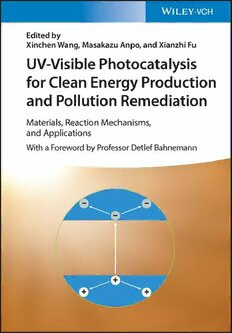
UV-Visible Photocatalysis for Clean Energy Production and Pollution Remediation: Materials, Reaction Mechanisms, and Applications PDF
Preview UV-Visible Photocatalysis for Clean Energy Production and Pollution Remediation: Materials, Reaction Mechanisms, and Applications
UV-VisiblePhotocatalysisforCleanEnergyProduction andPollutionRemediation UV-Visible Photocatalysis for Clean Energy Production and Pollution Remediation Materials, Reaction Mechanisms, and Applications Edited by Xinchen Wang, Masakazu Anpo, and Xianzhi Fu Editors AllbookspublishedbyWILEY-VCHarecarefully produced.Nevertheless,authors,editors,and Prof.XinchenWang publisherdonotwarranttheinformation FuzhouUniversity containedinthesebooks,includingthisbook, StateKeyLab.Photocatalysison tobefreeoferrors.Readersareadvisedtokeep EnergyandEnvironment inmindthatstatements,data,illustrations, No.2,XueyuanRoad proceduraldetailsorotheritemsmay 350116Fuzhou inadvertentlybeinaccurate. P.R.China LibraryofCongressCardNo.:appliedfor Prof.MasakazuAnpo FuzhouUniversity BritishLibraryCataloguing-in-PublicationData StateKeyLab.ofPhotocatalysison Acataloguerecordforthisbookisavailable EnergyandEnvironment fromtheBritishLibrary. No.2,XueyuanRoad 350116Fuzhou Bibliographicinformationpublishedby P.R.China theDeutscheNationalbibliothek TheDeutscheNationalbibliotheklists Prof.XianzhiFu thispublicationintheDeutsche FuzhouUniversity Nationalbibliografie;detailedbibliographic StateKeyLab.ofPhotocatalysisand dataareavailableontheInternetat Environment <http://dnb.d-nb.de>. 350116Fuzhou P.R.China ©2023WILEY-VCHGmbH,Boschstraße12, 69469Weinheim,Germany CoverImage:SchemebyProf.Masakazu Anpo Allrightsreserved(includingthoseof translationintootherlanguages).Nopartof thisbookmaybereproducedinanyform–by photoprinting,microfilm,oranyother means–nortransmittedortranslatedintoa machinelanguagewithoutwrittenpermission fromthepublishers.Registerednames, trademarks,etc.usedinthisbook,evenwhen notspecificallymarkedassuch,arenottobe consideredunprotectedbylaw. PrintISBN:978-3-527-35050-6 ePDFISBN:978-3-527-83797-7 ePubISBN:978-3-527-83798-4 oBookISBN:978-3-527-83799-1 CoverDesign:ADAMDESIGN,Weinheim, Germany Typesetting Straive,Chennai,India v Contents UV-VisiblePhotocatalysisforCleanEnergyProductionand PollutionRemediation:Materials,ReactionMechanisms,and Applications–APreface xv ListofContributors xix 1 Introduction 1 XinchenWang,MasakazuAnpo,andXianzhiFu 1.1 ChallengesandObjectivesintheUseofSolarEnergy 1 1.2 BriefHistoryoftheProgressinPhotocatalystsandPhotocatalytic Reactions 2 1.3 BriefIntroductionoftheChapters 4 1.4 ConclusionandPerspectives 6 References 6 PartI FundamentalsofPhotocatalysis 9 2 Visible-LightActivePhotocatalystsinPollutantDegradation/ ConversionwithSimultaneousHydrogenProduction 11 AmeneNaseri,MorasaeSamadi,andAlirezaZ.Moshfegh 2.1 Introduction 11 2.2 PrinciplesofSimultaneousPhotocatalysis 13 2.2.1 Dual-Functionalvs.ConventionalPhotocatalysts 13 2.2.2 ReactionEfficiencyEvaluation 15 2.3 CooperationPhotocatalystsforOrganicPollutant Degradation/ConversionandH FuelProduction 16 2 2.3.1 PhotocatalystDesign 16 2.3.2 OrganicSubstrateType 19 2.3.3 ReactionConditions 21 2.4 Conclusions 23 Acknowledgment 24 References 24 vi Contents 3 SelectiveOxidationofAlcoholsUsingCarbonNitride Photocatalysts 27 OleksandrSavateev 3.1 Introduction 27 3.2 Heptazine-BasedGraphiticCarbonNitrides 28 3.3 MechanismofAlcoholsOxidationbyCarbonNitrides 29 3.4 ImprovingSelectivityofAlcoholsOxidation 32 3.4.1 OptimizingReactionTimeandConversionofAlcohol 32 3.4.2 SubstitutingO byOtherOxidants 35 2 3.4.3 CombiningCarbonNitridePhotocatalystwithH EvolvingCatalyst 36 2 3.4.4 EmployingPhoto-ChargeableIonicCarbonNitridesUnderAnaerobic Conditions 36 3.5 Conclusion 38 References 38 4 ApplicationofS-SchemeHeterojunctionPhotocatalyst 41 ChuanbiaoBieandJiaguoYu 4.1 Introduction 41 4.2 HydrogenEvolution 44 4.3 CarbonDioxideReduction 46 4.4 PollutantDegradation 48 4.5 HydrogenPeroxideProduction 50 4.6 DisinfectionandSterilization 52 4.7 OrganicSynthesis 54 4.8 ConclusionandOutlook 55 References 56 5 TheRoleoftheDefectsonthePhotocatalyticReactionson ZnO 59 ZhongmingWang,WenxinDai,andXianzhiFu 5.1 Introduction 59 5.2 TypesofSurfaceDefectsandTheirElectricalStructure 60 5.2.1 OxygenVacancies 60 5.2.2 ZincVacancies 60 5.2.3 InterstitialOxygenandZinc 61 5.3 ControllablePreparationandCharacterizationofSurfaceVacancy Defects 62 5.3.1 ControllablePreparationofSurfaceVacancyDefects 62 5.3.1.1 FormationofVacancyDefectsviaAnnealingatDifferentConditions 62 5.3.1.2 FormationofVacancyDefectsviaMetalandNonmetalDoping 63 5.3.1.3 FormationofZnOwithVacancyDefectsviaHigh-EnergyElectronsand LightIrradiation 64 5.3.2 CharacterizationofSurfaceVacancyDefects 64 5.3.2.1 RamanSpectroscopy 64 5.3.2.2 X-rayPhotoelectron(XPS)Spectroscopy 64 Contents vii 5.3.2.3 ElectronParamagneticResonance(EPR)Spectroscopy 65 5.3.2.4 Photoluminescence(PL)Spectra 66 5.4 MechanismofSurfaceDefectsonPhotocatalyticReactionBehavior 66 5.4.1 RolesofDefectsinGasAdsorption 66 5.4.2 DefectsFunctionasaDouble-EdgedSwordinRegulatingPhotocatalytic Performance 69 5.4.3 DefectEngineeringRegulatesPhotocorrosionofZnO 70 5.4.3.1 RelationshipBetweenDefectsandPhotocorrosion 70 5.4.3.2 ConstructinganElectronChannelThroughElectronTransferuponthe AdsorptionofMoleculesandItsRoleinInhibitingPhotocorrosionof ZnO 70 5.5 ConclusionsandProspects 72 References 73 PartII PhotocatalyticSplittingofWatertoProduce Hydrogen 77 6 StrategiesforPromotingOverallWaterSplittingwith ParticulatePhotocatalystsviaSingle-StepVisible-Light Photoexcitation 79 JiadongXiao,XiaopingTao,andKazunariDomen 6.1 Introduction 79 6.2 SrTiO :Al/Rh/Cr O /CoOOH:AModelParticulateOWS 3 2 3 Photocatalyst 81 6.3 CurrentStrategiesPromotingOWSwithVisible-Light-Activated ParticulatePhotocatalysts 82 6.3.1 DefectControloftheSemiconductorMaterial 83 6.3.1.1 NewPrecursorDesigns 83 6.3.1.2 AliovalentDoping 84 6.3.2 Dual-CocatalystLoading 86 6.3.3 SurfaceNanolayerCoating 88 6.4 ConcludingRemarks 89 Acknowledgments 89 References 90 7 IntegrationofRedoxCocatalystsforPhotocatalyticHydrogen Evolution 93 MuhammadTayyab,YujieLiu,ZehongXu,SummanAman,WenhuiYue, RanaM.Irfan,LiangZhou,andJinlongZhang 7.1 Introduction 93 7.2 FundamentalsofDualCocatalysts 95 7.2.1 ClassificationofCocatalystsontheBasisoftheFunctional Mechanism 95 7.2.2 TheAdvantagesoftheDesignofDualCocatalysts 96 viii Contents 7.2.3 TheEffectofRedoxCocatalystParametersonPhotocatalysis 96 7.2.4 DesignPrinciplesofDualCocatalysts 97 7.3 RecentAdvancesintheConfigurationofDualRedox Cocatalysts/Photocatalyst 98 7.3.1 RandomDistribution 98 7.3.2 SpatiallySeparatedDistribution 99 7.3.2.1 Tip/SideDistribution 99 7.3.2.2 York-ShellDistribution 101 7.3.2.3 Facet-DependentDistribution 102 7.3.2.4 Center/EdgeDistribution 103 7.4 MajorTypesofPhotocatalyticWaterSplitting 103 7.5 Conclusions 105 References 105 8 PolymericCarbonNitride-basedMaterialsinAqueous SuspensionsforWaterPhoto-splittingandPhoto-reformingof BiomassAqueousSolutionstoGenerateH 109 2 E.I.García-López,G.Marcì,andL.Palmisano 8.1 Introduction 109 8.2 g-C N -basedPhotocatalystsforH Production 112 3 4 2 8.3 Conclusions 116 References 116 9 OrganicSupramolecularMaterialsforPhotocatalyticSplitting ofWatertoProduceHydrogen 119 XianjieChenandYongfaZhu 9.1 Introduction 119 9.2 OrganicSupramolecularPhotocatalystsforWaterSplitting 121 9.2.1 PDI-basedSupramolecularPhotocatalystsforHydrogenProduction 123 9.2.2 Porphyrin-basedSupramolecularPhotocatalystsforHydrogen Production 127 9.3 ConclusionandPerspectives 133 References 134 10 VisibleLight-responsiveTiO Thin-filmPhotocatalystsforthe 2 SeparateEvolutionofH andO fromWater 137 2 2 AswathyRajan,BernaurdshawNeppolian,andMasakazuAnpo 10.1 Introduction 137 10.1.1 FabricationofVisibleLight-responsiveTiO ThinFilms 138 2 10.1.2 CharacteristicsoftheVisibleLight-ResponsiveTiO ThinFilms 2 FabricatedbyRF–MSDepositionMethod 138
